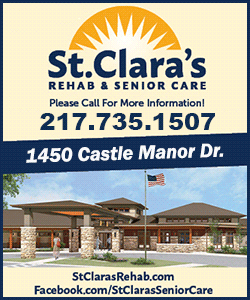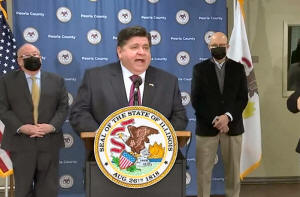Pritzker expecting to hit 100,000 daily vaccines in mid-March
 Send a link to a friend
Send a link to a friend
[February 25, 2021]
By JERRY NOWICKI
Capitol News Illinois
jnowicki@capitolnewsillinois.com
 SPRINGFIELD – Gov. JB Pritzker said
Wednesday the state expects to be receiving up to 100,000 doses of a
COVID-19 vaccine daily by mid-March, up from the approximately 60,000 it
is currently receiving on average. SPRINGFIELD – Gov. JB Pritzker said
Wednesday the state expects to be receiving up to 100,000 doses of a
COVID-19 vaccine daily by mid-March, up from the approximately 60,000 it
is currently receiving on average.
That’s counting only the already-approved Moderna and Pfizer-BioNtech
vaccines, and is not including a potential dosage spike that is expected
occur if the U.S. Food and Drug Administration approves a Johnson &
Johnson vaccine this week.
The FDA released an analysis Wednesday showing the Johnson & Johnson
vaccine has met the requirements for Emergency Use Authorization, which
is the same approval given to the two existing vaccines. The analysis
showed the vaccine is 66 percent effective against moderate to severe
COVID-19 globally, and an FDA panel is scheduled to meet Friday to
consider recommending authorization.

Pritzker said during a stop at a vaccination site in West Peoria that
even without the new vaccine, White House projections and promises from
vaccine manufacturers indicate the state will receive the 100,000 daily
doses by mid-March. That number could be increased by 20 percent with
approval of the new vaccine.
Peoria County Public Health Administrator Monica Hendrickson said the 66
percent effectiveness rate is less than the roughly 95 percent rate seen
with the first two vaccines, but it’s still more effective than the
seasonal flu vaccine, which hits roughly 40-60 percent depending on the
year. The Johnson & Johnson shot is also a one-dose vaccine, unlike the
two existing vaccines, which require two doses.
“You're looking at a distinction that from a clinical standpoint, or
from an epidemiological standpoint, is very minor compared to what we
really are hoping for which is decreases in death and decreases in
severe illness where they all match up between the three vaccines,” she
said. “The most important thing, though, is that when these vaccines
come on the market, if you have an option to any of these three, get one
of them.”
While Pritzker said nearly one in seven Illinoisans has had at least one
dose of a vaccine, he said he could not predict when the state can
progress from Phase 4 of reopening to Phase 5, which is essentially back
to normal with larger public gatherings allowed.
[to top of second column]
|

Gov. JB Pritzker joined local officials in West
Peoria Wednesday to discuss the state's vaccination efforts.
(Credit: Blueroomstream.com)

Entering Phase 5 is dependent on a widely available vaccine or
treatment, or the end of the virus’ spread.
“I've said from early on that what we need is an effective vaccine
that we can widely distribute or a very effective treatment that we
could widely distribute and we're getting there,” he said. “We need
to get closer to herd immunity for everybody to feel that we are
beyond Phase 4, and for us to actually be able to reopen everything
entirely.”
On Tuesday, the state reported 55,947 doses of the vaccine
administered, bringing the seven-day rolling average to 58,141.
About 4.9 percent of the state’s population has received two doses
of the vaccine, which over 14 percent had received at least one
dose, according to a database maintained by the New York Times.
That database showed the state was 20th of all the 50 states in
first doses given per capita, yet 49th for those having received two
doses. Pritzker attributed that to the state’s delay in opening up
the vaccination effort to Phase 1B, noting officials intentionally
remained in Phased 1A an extra week in what he said was an effort to
ensure all health care workers received their first shot.
Health departments are now receiving a majority of second doses, he
said.
The state is also planning on expanding Phase 1B eligibility
Thursday to include individuals older than 16 years of age who have
comorbidities and preexisting conditions.
Meanwhile, virus transmission rates continue to slow, as the rolling
seven-day average case positivity rate hit 2.6 percent Wednesday, a
low since July 9. The state reported 2,022 new confirmed or probable
cases among 82,976 test results reported over the previous 24 hours.

As of Tuesday night, there were 1,511 individuals hospitalized with
COVID-19 in Illinois, including 338 in intensive care unit beds and
172 on ventilators. Those numbers continued on a relative downward
trend.
The state also reported another 44 virus-related deaths Wednesday,
bringing the total to 20,374 since the pandemic began. The state has
logged more than 1.1 million cases out of 17.8 million test results
reported since the pandemic began.
Capitol News Illinois is a nonprofit, nonpartisan
news service covering state government and distributed to more than
400 newspapers statewide. It is funded primarily by the Illinois
Press Foundation and the Robert R. McCormick Foundation. |